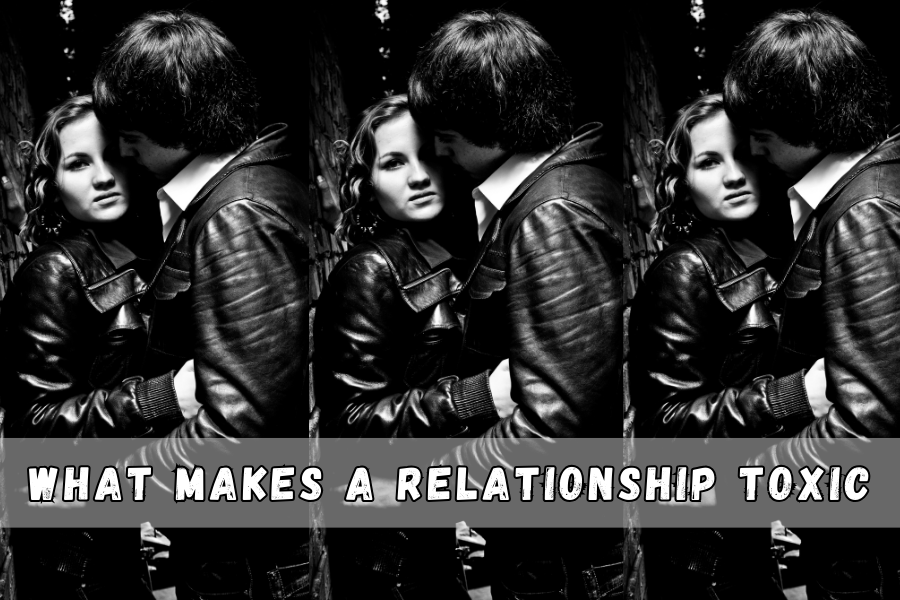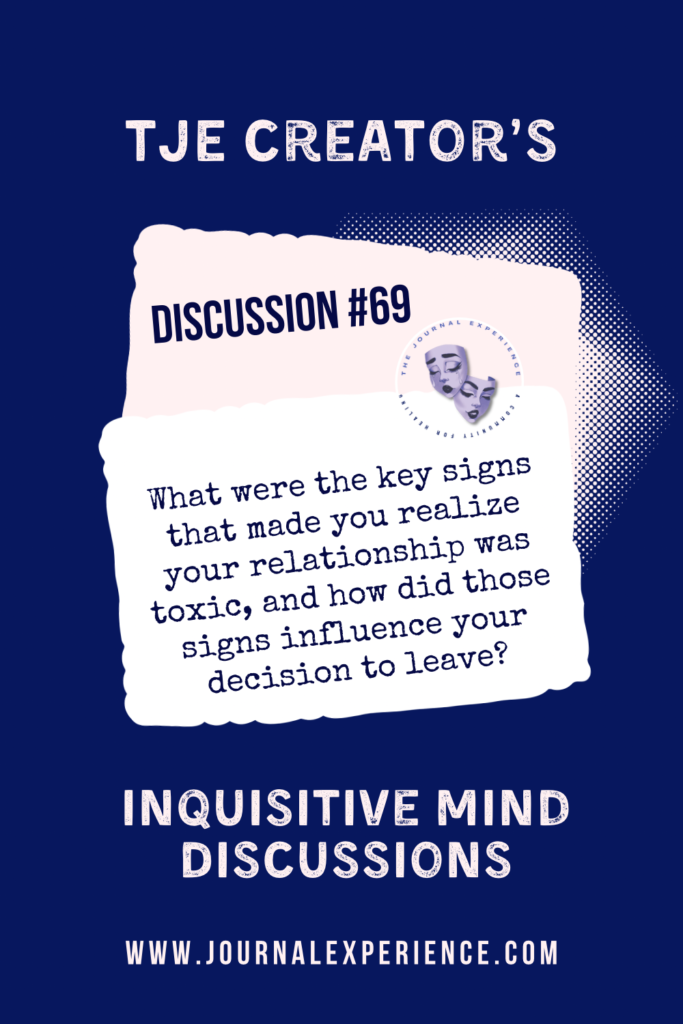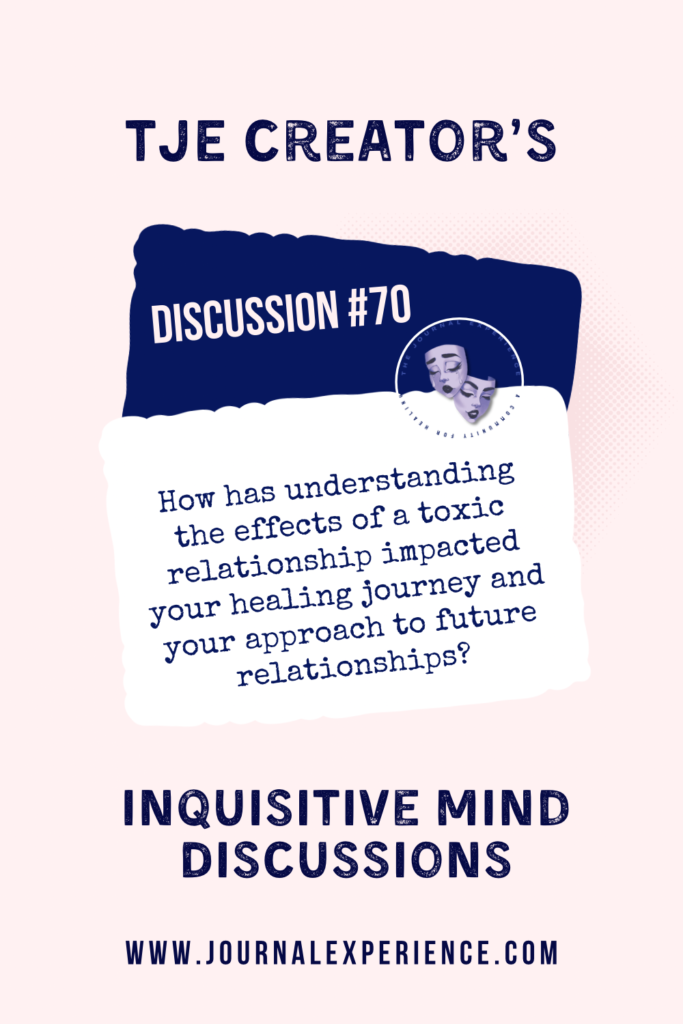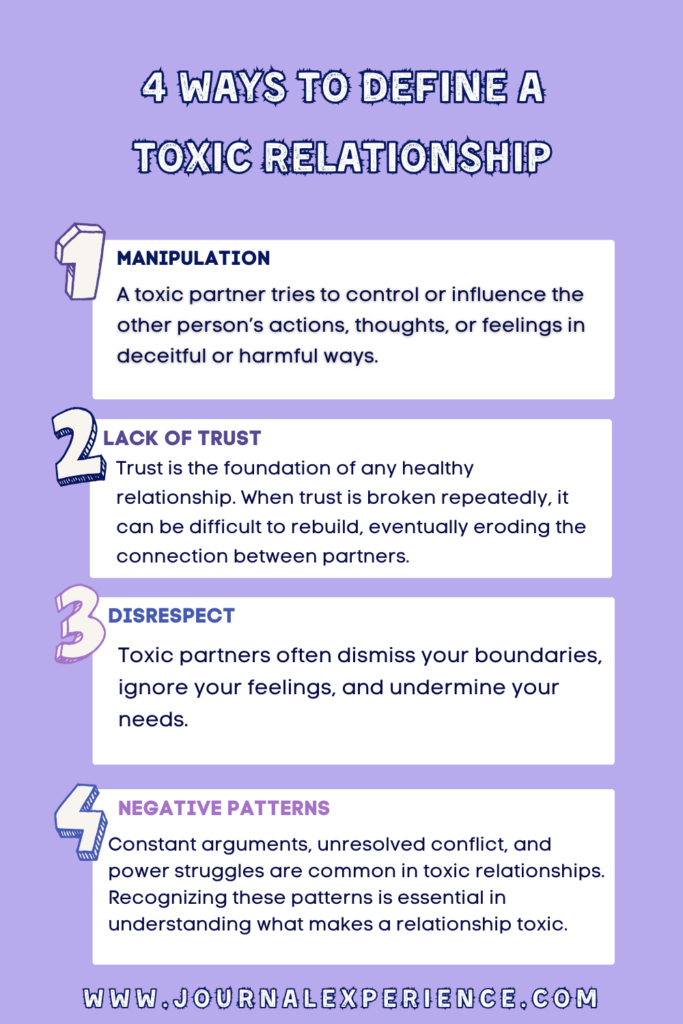Toxic relationships can affect your mental, emotional, and even physical well-being. Recognizing what makes a relationship toxic is the first step to protecting yourself and making empowered decisions about your future.

In this post, we will explore how toxic relationships manifest, the impact they can have, and provide actionable steps for getting out of them and recovering afterward. Whether you’re in a relationship or simply wish to be more aware of the signs, this guide will provide the tools you need to make healthier choices.
1. Defining a Toxic Relationship
A toxic relationship is not just an isolated incident of conflict or misunderstanding, but rather a recurring pattern of negative behaviors that harm one or both partners. These relationships are marked by consistent emotional distress, manipulation, and even abuse. Recognizing what makes a relationship toxic is crucial, as these harmful patterns undermine self-esteem and happiness over time.
Toxicity can take many forms, from emotionally draining behaviors such as constant criticism and control, to more overt signs of abuse like physical violence. The key to identifying what makes a relationship toxic is understanding that the negative patterns don’t just surface occasionally but are persistent and damaging.
Some key characteristics of toxic relationships include:
- Manipulation: A toxic partner tries to control or influence the other person’s actions, thoughts, or feelings in deceitful or harmful ways.
- Lack of trust: Trust is the foundation of any healthy relationship. When trust is broken repeatedly, it can be difficult to rebuild, eventually eroding the connection between partners.
- Disrespect: Toxic partners often dismiss your boundaries, ignore your feelings, and undermine your needs.
- Negative patterns: Constant arguments, unresolved conflict, and power struggles are common in toxic relationships. Recognizing these patterns is essential in understanding what makes a relationship toxic.
Toxic relationships are not limited to romantic partnerships. They can occur in friendships, family dynamics, and even work relationships, leaving deep emotional scars on those involved.

2. Identifying Signs of Toxic Relationships
Toxic relationships can be subtle at first, especially when emotional abuse or manipulation is involved. It’s crucial to be aware of the warning signs that indicate a relationship may be harmful. Here are several behaviors to watch for:
- Frequent Criticism: Criticism is part of any relationship, but in a toxic relationship, it is constant, harsh, and often aimed at belittling or diminishing the other person. If one partner routinely criticizes the other’s appearance, intelligence, or personal choices, it can lead to long-term damage to self-esteem. Recognizing these signs is key to understanding what makes a relationship toxic.
- Gaslighting: This form of manipulation makes one partner doubt their own reality or perception of events. If you often find yourself questioning your memories or feeling like you’re “crazy” because of your partner’s behavior, this is a major red flag and a clear indicator of toxicity.
- Emotional Manipulation: Emotional manipulators use guilt, shame, or fear to control their partner. Tactics such as guilt-tripping or withholding affection are common forms of manipulation in toxic relationships.
- Controlling Behavior: One partner may attempt to control what the other wears, who they see, or how they spend their time. While some couples may have preferences about things like activities or socializing, control becomes toxic when one partner tries to dictate every aspect of the other’s life.
- Physical Abuse: Physical violence is the most obvious and dangerous sign of a toxic relationship. It includes any form of harm, from slapping or pushing to more severe violence. No one should ever tolerate physical abuse in any form.
- Lack of Support: A toxic partner may dismiss your dreams, ignore your successes, or fail to offer emotional support when you’re struggling. In contrast, healthy relationships foster mutual encouragement and respect.
- Isolation: Toxic partners often isolate their significant others from friends, family, or social circles to exert more control. If you find yourself spending less time with loved ones and more time with a partner who discourages outside connections, it’s time to evaluate the relationship. Understanding these behaviors helps to recognize what makes a relationship toxic before it’s too late.
3. The Effects of Toxic Relationships on Individuals
Staying in a toxic relationship can have serious, long-term effects on your emotional, mental, and even physical health. Here are some of the most common consequences:
- Anxiety and Depression: The emotional strain of constant conflict, criticism, and manipulation can lead to feelings of anxiety, depression, and helplessness. The stress can impact your overall mood, and you may feel a sense of dread every time you interact with the toxic partner.
- Low Self-Esteem: Toxic relationships are notorious for chipping away at a person’s self-worth. Constant criticism, emotional manipulation, and neglect can make you feel unworthy of love and respect. Over time, this can lead to deep self-doubt and an inability to trust your own instincts.
- Chronic Fatigue: Toxic relationships can drain you emotionally and physically. The constant stress of trying to manage conflict, repair trust, or avoid confrontation can leave you feeling exhausted and depleted.
- Difficulty Trusting Others: After enduring a toxic relationship, you may find it difficult to trust new people, including potential partners or friends. The betrayal of trust in the toxic relationship can leave scars that prevent you from forming healthy, trusting relationships in the future.
- Behavioral Changes: Over time, staying in a toxic relationship may cause you to adopt unhealthy coping mechanisms, such as emotional numbing, substance abuse, or withdrawal from social situations. These behaviors can have their own damaging consequences.
Recognizing these effects is crucial for understanding what makes a relationship toxic and how it can harm your overall well-being.

If a toxic relationship has left you emotionally exhausted, disconnected from yourself, or battling anxiety and shame, the Healing The Inner Trauma Child (HITCH) Method offers deep emotional healing and guidance to help you rebuild your sense of safety, worth, and identity.
4. How to Leave a Toxic Relationship
Leaving a toxic relationship can be incredibly difficult, especially if there is emotional or physical abuse involved. However, it is vital for your mental and emotional well-being to prioritize your safety and happiness. Here’s how you can begin to take action:
- Acknowledge the Toxicity: Denial can be a powerful force. It’s easy to make excuses for a toxic partner or to justify their behavior, especially when you still love them or are afraid of confrontation. Acknowledge that the relationship is unhealthy and that you deserve more.
- Create a Support System: Reach out to friends, family, or a therapist for emotional support. They can offer guidance, strength, and perspective during this challenging time.
- Develop an Exit Plan: If you feel unsafe or uncertain about how to leave, create a plan. This may involve finding a safe place to stay, gathering necessary documents, or blocking the toxic person on social media to ensure no further manipulation or harassment.
Set Clear Boundaries: When preparing to leave, communicate your intentions clearly to the toxic partner. Set boundaries and stick to them, even if they try to guilt you into staying or promise to change.
- Go No-Contact: In many cases, cutting off all contact is the best way to protect yourself from further manipulation, emotional abuse, or confusion. This may feel painful, but it’s essential to give yourself space to heal and move forward.
Taking these steps is essential to recognizing what makes a relationship toxic and creating a safer, healthier future.
5. Recovery After Leaving a Toxic Relationship
Leaving a toxic relationship is often just the beginning of a long recovery process. Healing takes time and effort, but it is entirely possible. Here’s how to begin:
- Allow Yourself to Grieve: Even if the relationship was toxic, it’s normal to grieve its loss. You may mourn the hopes, dreams, and connection you once shared with that person. Allow yourself to feel the emotions that arise and process them in a healthy way.
- Practice Self-Care: After leaving a toxic relationship, it’s vital to focus on taking care of yourself. This might mean getting enough rest, eating nourishing foods, exercising, or engaging in activities that bring you joy and fulfillment.
- Seek Professional Help: Therapy or counseling can be an invaluable resource for processing the trauma of a toxic relationship. A therapist can help you rebuild your self-esteem, manage the effects of anxiety and depression, and learn to trust again.
If you’re learning to trust again and break free from emotional dependency, the Codependency Therapy | Self Love Recovery Treatment Program offers structured, step-by-step support to rebuild your emotional independence and prevent repeating toxic cycles.
- Rebuild Your Support System: Reconnect with supportive friends and family who can offer encouragement and a sense of security. Having a strong network around you can help you heal and move forward.
Overview
Toxic relationships can deeply impact your overall well-being, affecting not just your emotional and mental health, but also your physical health. Often, people find themselves in toxic relationships without even realizing it until the negative effects begin to take their toll. Recognizing what makes a relationship toxic is the crucial first step toward taking control of your life and making empowered decisions that protect your future happiness. Whether you’re currently in a relationship or you simply wish to be more aware of the subtle signs, understanding the dynamics of toxicity is essential for cultivating healthy connections.

Understanding the psychological roots of toxic relationships is crucial for long-term healing. The Webinar: Origins of Codependency and Pathological Narcissism offers empowering insights into how early emotional wounds shape your relationships—and how to stop repeating the cycle.
If you haven’t already, become a member of The Journal Experience or subscribe to the TJE Newsletter to continue receiving valuable insights and support. Join the experience and take the first step toward a healthier, happier future.